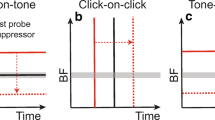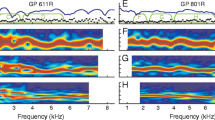Abstract
A method is presented which determines the solution of the one-dimensional cochlear model in the form of a convergent series. The leading term of the series is the unreflected wave component, which can also be derived by means of the Liouville-Green approximation. The higher order terms each represent waves which have been reflected a particular number of times by the inhomogeneity of the medium. The main conclusions of the study are: (i) There is a distinct asymmetry in reflection of cochlear waves. Reverse waves, travelling towards the stapes, are much more reflected than waves travelling towards the helicotrema. (ii) The decline of the stiffness of the basilar membrane is the principal feature determining the reflection properties.
Access this chapter
Tax calculation will be finalised at checkout
Purchases are for personal use only
Preview
Unable to display preview. Download preview PDF.
Similar content being viewed by others
References
Boer, E. de, Kaernbach, C., König, P. and Schillen, T. (1986). Forward and reverse waves in the one-dimensional model of the cochlea, Hearing Res., in press.
Boer, E. de and Viergever, M.A. (1982). Validity of the Liouvilie-Green (or WKB) method for cochlear mechanics, Hearing Res. 8, 131–155.
Boer, E. de and Viergever, M.A. (1984). Wave propagation and dispersion in the cochlea, Hearing Res. 13, 101–112.
Bremmer, H. (1951). The WKB approximation as the first term of a geometrical-optical series, Comm. Pure and Appl. Math. 4, 105–115.
Guelke, R.W. and Bunn, A.E. (1985). A mechanism for stimulated acoustic emissions in the cochlea, Hearing Res. 19, 185–189.
Steele, C.R. and Taber, L.A. (1979). Comparison of WKB and finite difference calculations for a two-dimensional cochlear model, J. Acoust. Soc. Am. 65, 1001–1006.
Viergever, M.A. (1980). Mechanics of the inner ear - a mathematical approach, Delft University Press.
Viergever, M.A. (1986). Cochlear macromechanics - a review, in: Peripheral auditory mechanisms, J.B. Allen, J.L. Hall, A. Hubbard, S.T. Neely, and A. Tubis (eds.), Springer Verlag, Berlin, 63–72.
Viergever, M.A. and Diependaal, R.J. (1986). Quantitative validation of cochlear models using the Liouville-Green approximation, Hearing Res. 21, 1–15.
Zweig, G., Lipes, R., and Pierce, J.R. (1976), The cochlear compromise, J. Acoust. Soc. Am 59, 975–982.
Author information
Authors and Affiliations
Editor information
Editors and Affiliations
Rights and permissions
Copyright information
© 1986 Plenum Press, New York
About this chapter
Cite this chapter
Viergever, M.A. (1986). Asymmetry in Reflection of Cochlear Waves. In: Moore, B.C.J., Patterson, R.D. (eds) Auditory Frequency Selectivity. Nato ASI Series, vol 119. Springer, Boston, MA. https://doi.org/10.1007/978-1-4613-2247-4_4
Download citation
DOI: https://doi.org/10.1007/978-1-4613-2247-4_4
Publisher Name: Springer, Boston, MA
Print ISBN: 978-1-4612-9316-3
Online ISBN: 978-1-4613-2247-4
eBook Packages: Springer Book Archive




